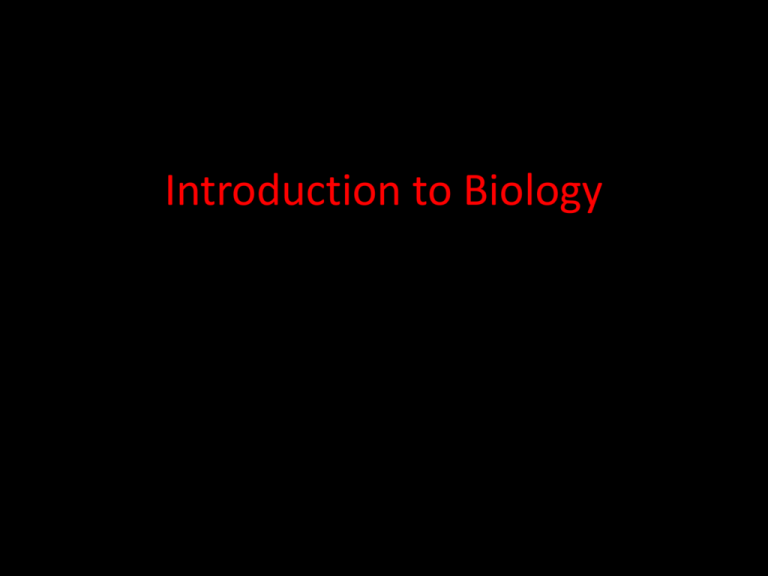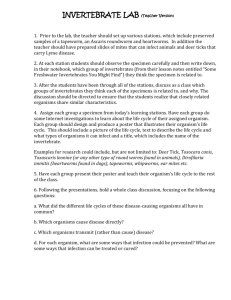Introduction to Biology
advertisement

Introduction to Biology What is definition of Biology? • It is the Study of Life • What do Biologist Study? • Everything from tiny organisms to large elephants. • Even food you eat to exercise and what air and land will be like in the future. Biology and Society • By studying biology we can make decisions that impact our everyday life. • Everyday there is news that may relate to local issues of pollution to new inventions. • They also work to improve the food and cures for disease. 7 Characteristics of Life 1. 2. 3. 4. 5. 6. 7. Organization and presence of one or more cells Response to Stimulus (plural, Stimuli) Homeostasis Metabolism Growth and Development Reproduction Change through time Organization • High degree of order within an organisms internal and external parts and interaction within the living world. Cell • All living things are made of cells • Is the smallest unit of life • Unicellular- organism that is made of one cell (ex: Bacteria) • Multicellular- organism made of one or more cells ( ex: Humans) • Most complex organisms have organ systems • Organs- structures that carryout special functions within the system • Tissues- groups of cells have similar abilities allow organ to function • Organelles- tiny structures that carry out functions in order to stay alive • Biological molecules- chemical compounds provide structure and provide movement, energy, and other cellular functions for the organelle • All biological molecules are made of atoms- the simplest particle of an element • Another characteristic of life is a response to a stimulus- physical or chemical change in the internal or external environment. (ex: bright light) Homeostasis • Is the maintenance of a stable level of internal conditions even when external ones change • Regulatory systems maintain levels of nutrients, temperature and water intake Metabolism • Sum of chemical reactions that take in and transform energy and materials from environment • Organisms use energy to power all life processes • Plants, algae and bacteria use sun to generate sugar molecules. • What is this process know as? Photosynthesis Growth and Development • All living things grow and increase in size • Growth of living things comes from cell division • Cell division is the formation of two new cells from and existing one( fig 1-3 in book) • Multicellular organisms mature through cell division, cell enlargement and development • Development- process in which organism becomes mature adult – It involves cell division and differentiation, or specialization – Human body is composed of trillions of these specialized cells. Help in carrying oxygen in body of hearing Reproduction • Is the process of producing organisms like themselves • Reproduction is not essential to an individual organisms, but it is for the species to survive • During reproduction organisms transmit deoxyribonucleic acid (DNA) • A short segment of DNA is known as a gene • Sexual reproduction- DNA from 2 different people creates a similar but different from parents • Asexual reproduction- DNA from only one organism is combined for a organism that is genetically the same Change through time • Organisms must change and will change over time or evolve to survive. There basic genetics characteristics will remain the same Diversity and Unity of Life • Unity- features that all living things have in common • One feature is the genetic code in DNA • Another feature is organelles and the activities that they carry out. • Diversity is defined in the tree of life and the lineages that each organism follows. The more similar the closer they are on the branches of the tree. The more distantly related are on further branches. 3 Domains of Life • Bacteria • Archaea • Eukarya • Bacteria and Archaea have less complex cells than Eukarya • Eukarya- most familiar organisms, animals, plants and fungi 6 Kingdoms • • • • • • • Animalia Plantae Fungi Protista Archaea Bacteria This is how most organisms are grouped together Interdependence of Organisms • Ecology- branch of biology study organisms interacting in an environment • Ecosystems- communities of living species and physical environments. Where on single species can live Evolution of life • Evolution- process where inherited characteristics change over generations, such that new species can develop Natural Selection • Natural selection-organisms that have favorable traits may survive and reproduce more successfully than those lack these traits • Adaptations- traits that improve ones ability to reproduce and survive – Ex: species that blend into environment to hide and hunt Scientific Method • • Steps of the Scientific Method Although there is no single method for doing science, scientific studies involve a series of common steps. • 1.The process of science begins with an observation. An observation is the act of perceiving a natural occurrence that causes someone to pose a question. • 2.One tries to answer the question by forming hypotheses (singular, hypothesis). A hypothesis is a proposed explanation for the way a particular aspect of the natural world functions. • A prediction is a statement that forecasts what would happen in a test situation if the hypothesis were true. A prediction is recorded for each hypothesis. • An experiment is used to test a hypothesis and its predictions. • • Once the experiment has been concluded, the data are analyzed and used to draw conclusions. After the data have been analyzed, the data and conclusions are communicated to scientific peers and to the public. This way others can verify, reject, or modify the researcher’s conclusions. Forming Hypothesis 1. Observation 2. Questioning 3. Hypothesis-making a prediction that can be tested and gather data 4. Design an experiment 1. Control group- provides normal standard in controlled experiment 2. Experimental group- is identical to control except for one factor the independent variable(also known as manipulated variable) 3. Dependent variable- responding variable or observed changes from independent variable Collecting and Analyzing Data 5. Quantitative Data- measuring a variable(dependent) in numbers – Data is collecting and compared to prior results and then put into graphs or tables to see possible errors and similarities 6. Drawing conclusions- using data to support the hypothesis and to disprove only. • Theory- set of hypothesis have been confirmed true and confirmed by great amount of data • BIG BANG THEORY • (Funny TV Show) • Peer review- after writing a journal from the experiment findings it is sent out for review by other scientists anonymously for critique Microscopes • Compound light • 1.Eyepiece The eyepiece(ocular(AHK-yoo-luhr) lens) magnifies the image, usually 10 times. • 2.Objective Lens Light passes through the specimen and then through the objective lens, which is located directly above the specimen. The objective lens enlarges the image of the specimen. Scientists sometimes use stains to make the image easier to see. • 3.Stage The stage is a platform that supports a slide holding the specimen. The slide is placed over the opening in the stage of the microscope. • 4.Light Source The light source is a light bulb that provides light for viewing the image. It can be either light reflected with a mirror or an incandescent light from a small lamp. • Magnification- increase in object apparent size • Nosepiece- structure holds objective lens • Resolution- power to show details clearly Scanning Electron Microscope • SEM- scans a beam of electrons over the specimen surface giving a 3D image. • SEM can magnify up to 100,000x Transmission Electron Flagellum • TEM – transmits electrons through the specimen to magnify up to 200,000x







